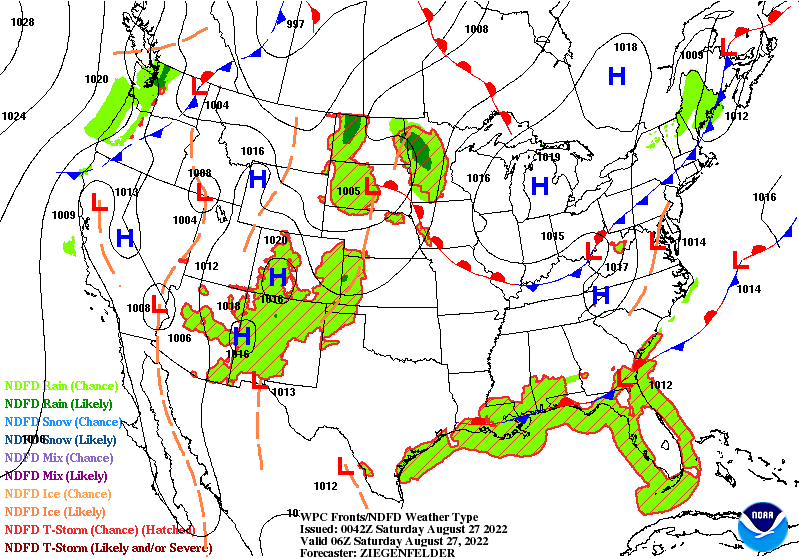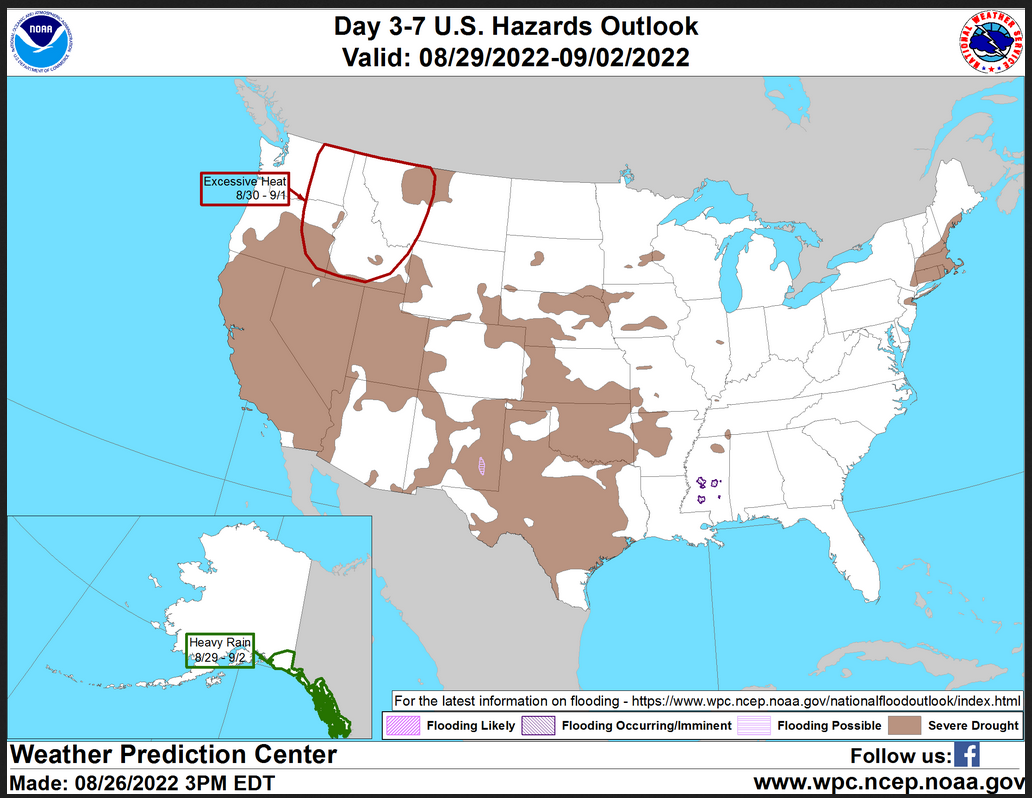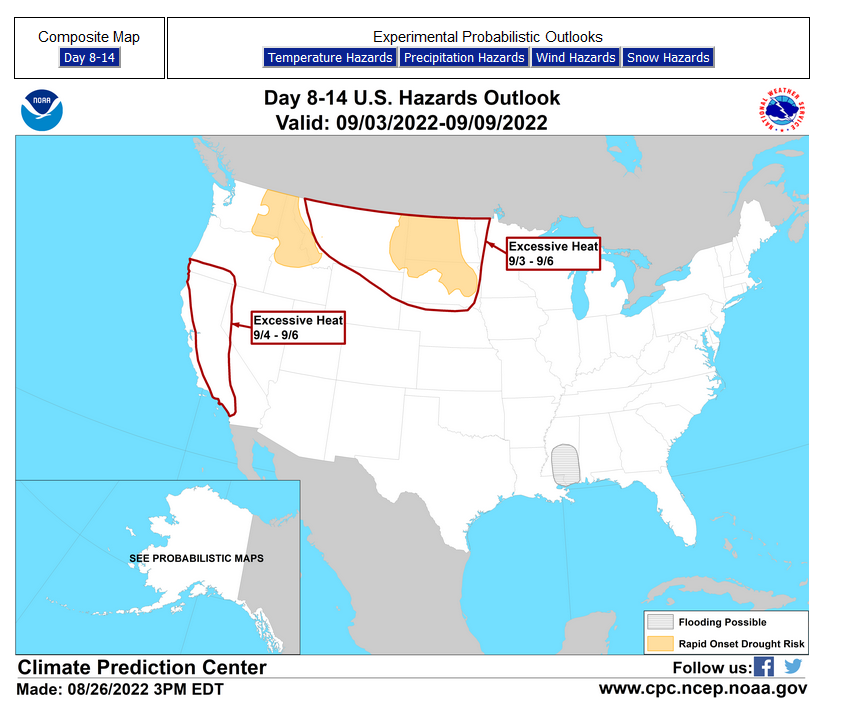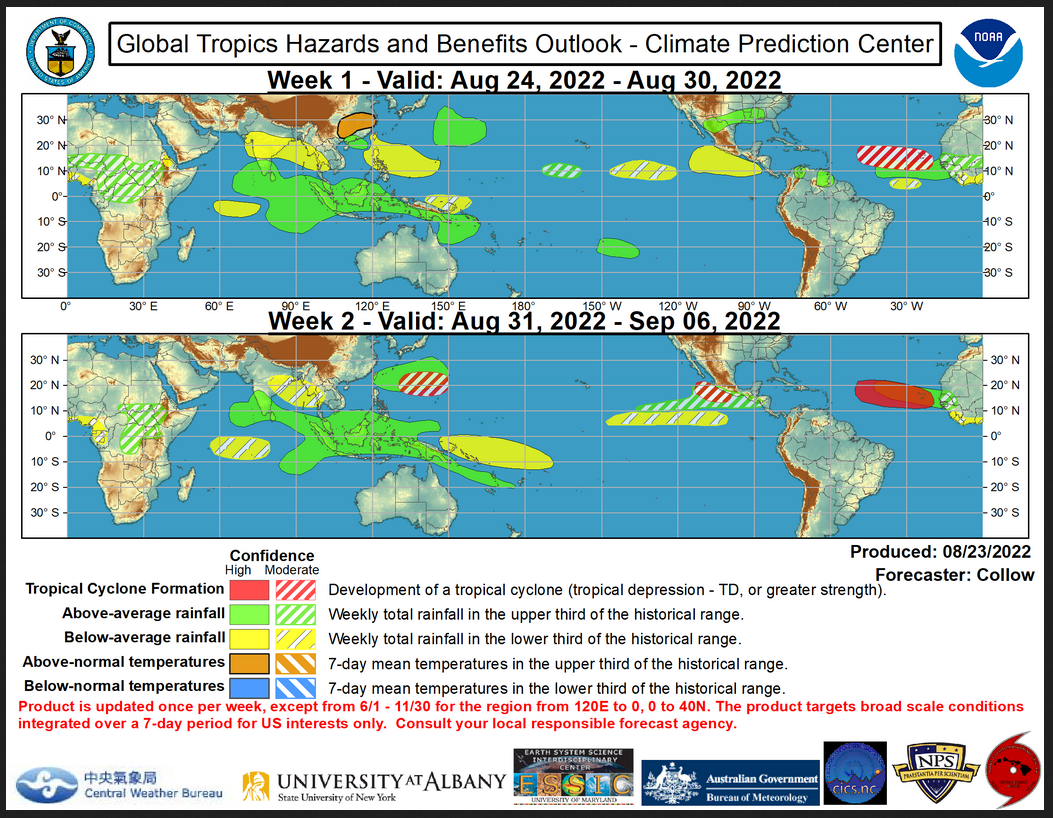Here is what we are paying attention to tonight and the next 48 hours from this evening’s NWS Forecast.
...There is a Slight Risk of excessive rainfall over parts of the Lower Mississippi Valley/Central Gulf Coast through Saturday morning... ...There is a Slight Risk of severe thunderstorms over parts of the Northeast through Saturday morning... ...Increasing fire weather risk over parts of the Great Basin, Northern Intermountain Region, and Northern Rockies...
Continuation of the NWS Short Range Forecast (It is updated twice a day and these updates can be found here.
Tropical moisture, upper-level energy, and a weak front over parts of the Central Gulf Coast into the Southeast will aid in producing showers and thunderstorms with heavy rain over parts of Louisiana, Mississippi, Alabama, and the western parts of the Florida Panhandle. Therefore, the WPC has issued a Slight Risk of excessive rainfall over parts of the Lower Mississippi Valley and Central Gulf Coast through Friday morning. The associated heavy rain will create mainly localized areas of flash flooding, with urban areas, roads, and small streams the most vulnerable. The threat of excessive rainfall reduces on Saturday over the Western/Central Gulf Coast/Southeast. However, the system will continue to produce showers and thunderstorms with possible heavy rain over the area on Saturday and Sunday. Therefore, the WPC has issued a Marginal Risk of excessive rainfall over parts of the Western/Central Gulf Coast and Southeast from Saturday into Sunday. The associated heavy rain will create localized areas of flash flooding, affecting areas that experience rapid runoff with heavy rain. Meanwhile, monsoonal moisture and upper-level energy will aid in producing diurnal showers and thunderstorms over parts of the Southwest, Great Basin, and Central/Southern Rockies. Therefore, the WPC has issued a Marginal Risk of excessive rainfall over parts of the Southwest, Great Basin, and Central/Southern Rockies through Sunday morning. The associated heavy rain will create localized areas of flash flooding, affecting areas that experience rapid runoff with heavy rain. On Saturday, drier air will begin to move into parts of the Great Basin and the Central/Southern Rockies. Therefore the threat of excessive rainfall will decrease over the region on Sunday. However, diurnally driven monsoonal moisture showers and thunderstorms will decrease significantly on Sunday evening. In the meantime, a wave of low pressure and associated front over the Northeast will push off the Northeast Coast by Saturday. The system will produce showers and thunderstorms over parts of the Northeast into the Central Appalachians through late Friday night. The low pressure will destabilize the atmosphere over parts of the Northeast, producing showers and thunderstorms that will become severe. Therefore, the SPC has issued a Slight Risk of severe thunderstorms over parts of the Northeast through Saturday morning. The hazards associated with these thunderstorms are frequent lightning, severe thunderstorm wind gusts, hail, and a few tornadoes. Moreover, a developing front over the Northwest will move eastward to the Northern/Central Plains by Sunday. The system will produce light rain over parts of the Pacific Northwest through Saturday. As the storm begins to pull out of the Rockies into the Plains, a plume of moisture will move into Upper Midwest ahead of the system on Saturday into Sunday. An upper-level impulse ahead of the front will aid in producing showers and thunderstorms over parts of the Upper Midwest into the Central Plains on Saturday, moving into the Great Lakes and the Ohio Valley on Sunday. Therefore, the WPC has issued a Marginal Risk of excessive rainfall over parts of the Upper Midwest into Central/Southern High Plains on Saturday, moving into the Upper Great Lakes to Middle Mississippi Valley by Sunday. The associated heavy rain will create localized areas of flash flooding, affecting areas that experience rapid runoff with heavy rain. Furthermore, lowering relative humidity, increasing surface winds, and dry thunderstorms will contribute to fire weather concerns over parts of the Great Basin. Therefore, the SPC has issued an Elevated Risk of fire weather over parts of the Great Basin through Saturday morning. The threat of fire weather increases on Saturday. Therefore, the SPC has issued a Critical Risk of fire weather over parts of the Great Basin, expanding into the Northern Intermountain Region and Northern Rockies on Saturday into Sunday morning.
Maps that relate the forecast to geography can be found by clicking Here for Day 1 and Here for Day 2.
Here is a 60-hour animated forecast map that shows how the short-term forecast is expected to play out.
If it needs to be updated click here.
HAZARDS OUTLOOKS
Click here for the latest complete Day 3 -7 Hazards forecast which updates only on weekdays. Once a week probably Monday or Tuesday I will update the images. I provided the link for readers to get daily updates on weekdays. Use your own judgment to decide if you need to update these images.
Worldwide Tropical Forecast
(This graphic updates on Tuesdays) If it has not been updated, you can get the update by clicking here
Detailed Maps and Reports for the Western Atlantic and the Pacific Oceans
Below are three maps that summarize the situation for the Atlantic, Eastern and Central Pacific. Additional information can be accessed by clicking HERE
First the Atlantic
Click to view the forecast map and have access to additional information https://www.nhc.noaa.gov/gtwo.php?basin=atlc&fdays=5
Then Eastern Pacific
Click to view the forecast map and have access to additional information https://www.nhc.noaa.gov/gtwo.php?basin=epac&fdays=5
Then Central Pacific
Click to view the forecast map and have access to additional information https://www.nhc.noaa.gov/gtwo.php?basin=cpac&fdays=5
And the Western Pacific
Click to view the forecast map and have access to additional information https://www.metoc.navy.mil/jtwc/jtwc.html
Some Intermediate-Term Outlooks
Links to “Outlook” maps and discussions for three time periods. Days 6 – 10, Days 8 – 14, and Weeks 3 and 4. An outlook differs from a forecast based on how NOAA uses these terms in that an “outlook” presents information from deviation from normal and the likelihood of these deviations.
You have to click on the links because they do not update automatically and I do not want to have stale images in the article. But it is not difficult to click on a link and you get a large image plus a discussion. On Fridays in a separate article, we will show the images and provide a link in this article that article. But remember what you will see is the images as of Friday. But here you can get the current images simply by clicking on them. Then hit the return arrow at the upper left of your screen to return to the article. You will not find this information easily anywhere else.
Right now you can find these maps here (We show them every Friday there but you can click above and find them).
World Forecast for Day 6 (Currently Set for Day 6 but the reader can change that)
World Weather Forecast produced by the Australian Bureau of Meteorology. Unfortunately, I do not know how to extract the control panel and embed it into my report so that you could use the tool within my report. But if you visit it Click H ere and you will be able to use the tool to view temperature or many other things for THE WORLD. It can forecast out for a week. Pretty cool. Return to this report by using the “Back Arrow” usually found top left corner of your screen to the left of the URL Box. It may require hitting it a few times depending on how deep you are into the BOM tool. Below are the current worldwide precipitation and air pressure forecasts for six days out. They will not auto-update and right now are current for Day 6. If you want the forecast for a different day Click Here I will try to update this map each day but you have the link so you can access the dashboard and get a wide variety of forecasts.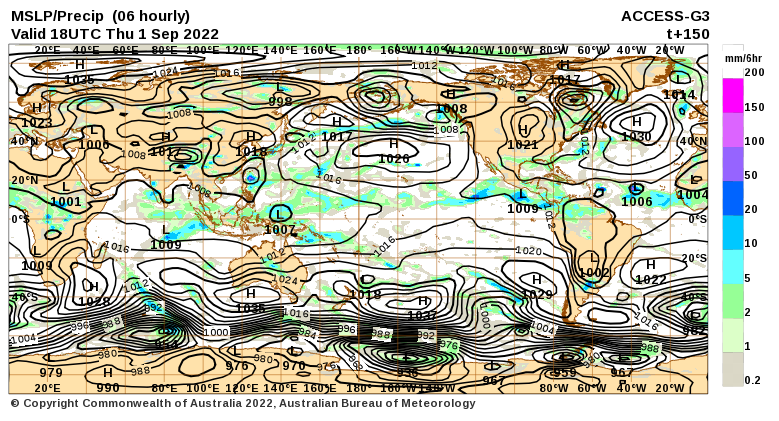 I mostly rely on the reader to interpret world maps. For this map, areas of expected precipitation for the date and time shown are clearly shown.
I mostly rely on the reader to interpret world maps. For this map, areas of expected precipitation for the date and time shown are clearly shown.
The number of High-Pressure systems shown is called the Wave Number. Maybe I will discuss WN someday. But it shows how many Rossby Waves there are around the World. Sometimes they are hard to count. Counting Low-Pressure systems should provide the same WN. Rossby Waves are the way the temperature distribution of the Planet remains in balance. It is basically the science of fluid dynamics. It can be very helpful in predicting the movement of weather patterns. You can snip an area of interest and move it into MS Paint and enlarge it.
Month to Date Information
Month to date Temperature can be found at https://hprcc.unl.edu/products/maps/acis/MonthTDeptUS.png
Month to date Precipitation can be found at https://hprcc.unl.edu/products/maps/acis/MonthPNormUS.png

